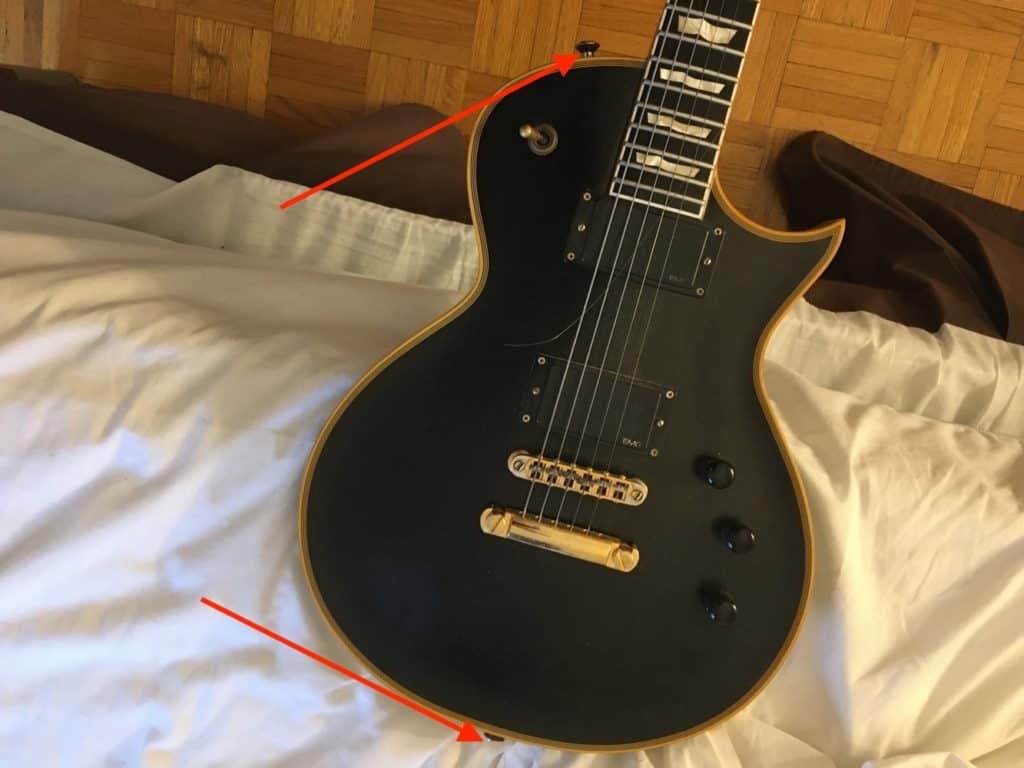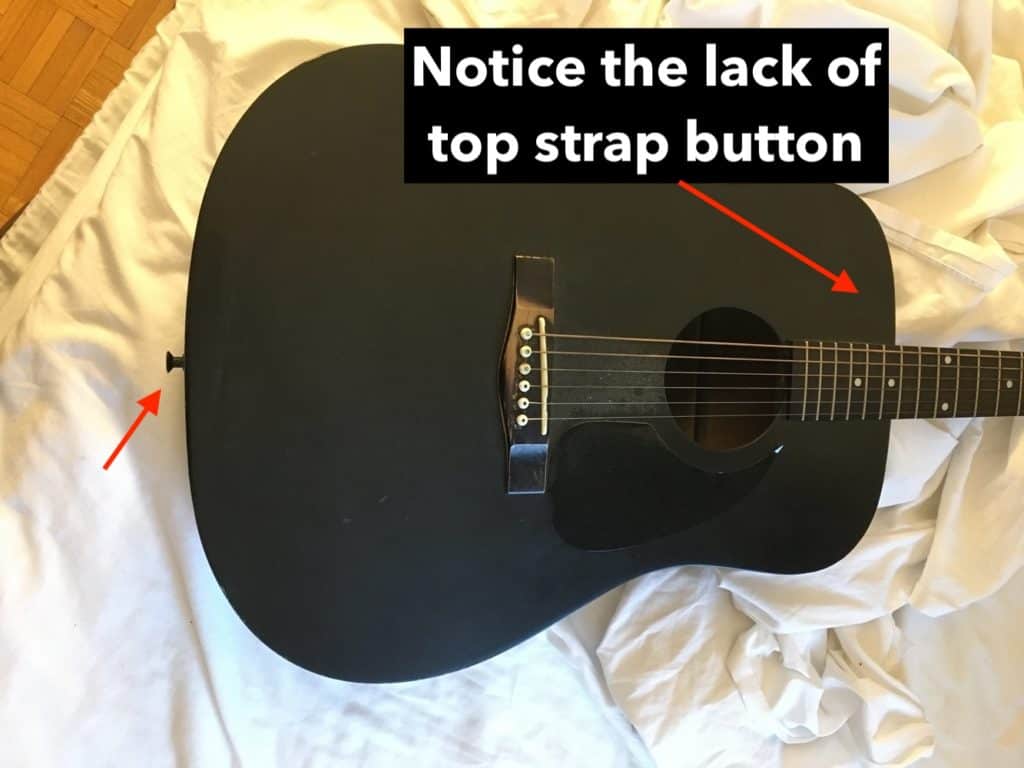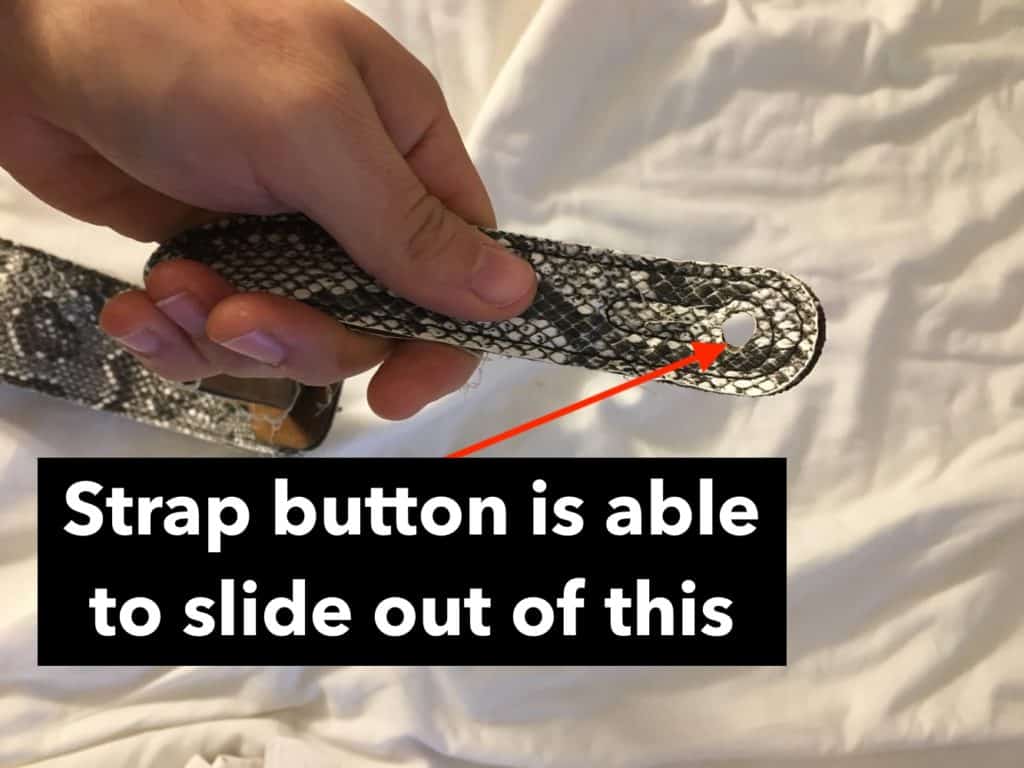Because there’s a lot of gear out there for guitarists and other instrumentalists, there is much variability, especially when you get into more niche or specialized equipment. One example would be pickups. While most are passive, active pickups are available and these necessitate a battery, unlike their passive counterpart.
The same thing can often be said about guitar strap pins, which are nearly always the same on guitars. Most guitar straps will work the same way on other guitars, but they’re not always built in the same way. For instance, some guitar straps are locked into place.
Simply put, guitar straps are usually universal because the mechanism that holds each strap in place is usually the same. The strap buttons on the top and bottom of the guitar are usually identical. So as long as the strap has the two holes on it that slide over the button, the strap will work just fine.

With that said, there are a variety of types of straps, many of which have different designs; are made out of different materials; and in some cases, come with a locking mechanism that way the strap buttons don’t slip out of the strap when you’re in the middle of playing, which is a very real problem.
While guitar straps are typically universal and work with all kinds of guitars, we’re going to talk briefly about some of the different types out there, as well as what type of strap, with what features, you should be using for what you’re doing.
The type of guitar strap that you have can really make a difference in a number of ways, including in terms of total comfort over a long period of time, or over a short period of time, while others just don’t seem to last that long.
It’s worth mentioning that the type of strap you have may work better for different types of instruments. For instance, while a guitar strap will tend to work just fine for bass, there are better straps out there that are more suitable for the bass guitar due to the fabric and strength of it.
Additionally, when it comes to the acoustic guitar, it’s not uncommon at all for the acoustic to have only one strap button it, which is usually on the bottom of the body, whereas it doesn’t have a strap button near the beginning of the top of the neck, like where it would be on an electric.

On an acoustic guitar, you might need to attach a string to the headstock so the strap has something to actually latch on to. In some cases, some people might actually take the instrument to a luthier to add a strap button to the guitar.
This is a great move if you’re always performing with the guitar standing up.
As I just noted, bass players, want a strap that’s thicker and longer to compensate for the extra size of the instrument.
For that reason, if you’re using a bass guitar, you might need to drop a bit more cash to ensure that the strap you’re using will be as comfortable as possible, long enough, and it actually holds the thing.
Things To Considering When Purchasing A Strap
In general, you want to look out for four different qualities of a strap when making a purchase, including the fabric, whether there’s a locking mechanism or not, the width, as well as the length of it.
Additionally, you should take a look at the holes and make sure they will actually fit the strap button, although this usually won’t be an issue.
1) Fabric
When it comes to the actual fabric of what the strap is made out of, they are usually constructed out of a few different materials, including neoprene or memory foam, leather, cotton, or nylon.
Personally, I would argue that leather is the best and will also last the longest, and also it’s much easier to repair in the case of it breaking, which it probably won’t. Additionally, leather guitar straps are a little bit more money.
2) Width of the Strap
Typically, the width of a guitar strap is between 2″ and 4″ from each side to the other. The wider the strap, the more comfortable it is over the long term, and it’s also better for supporting much larger instruments.
Additionally, wider straps, because they’re bigger and use more product, they usually cost more money, but they’re usually meant for the people who are the most serious about getting the most comfort out of their strap as possible.
On the other hand, some people find that thicker straps are unnecessarily big, and kind of get in the way, but it’s really up to the individual and their preferences.
3) Length of the Strap
Normally, a standard guitar strap falls between 40 and 60 inches, but can often go all the way up to 70 inches, especially in the case of a bass guitar. If the guitar strap falls between these ranges, that means it’s going to work for nearly everybody on earth.
If you’re a huge guy, or you play the bass guitar, you’re going to need a bigger rather than smaller strap.
4) Locking Machine
I don’t know about you, but I’ve had this problem many different times in my life. Guitars can actually slip out of the strap unexpectedly and fall to the ground, which is quite annoying.
For that reason, some manufacturers make a locking mechanism that automatically takes care of this problem.

If you’ve ever seen guitar players swing their guitar around their body when playing on stage, which was especially common in the pop-punk days, they’re more than likely using the locking mechanisms which stop the guitar from slipping out and hitting the ground.
People who use locking mechanisms on the guitar are usually sick and tired of the guitar slipping out of the strap, which is definitely quite annoying, while others think it’s gimmicky and not necessary. But it’s really up to the person who’s using it.
There are a number of ways you can get a locking mechanism on the guitar, including the actual strap buttons, or the strap itself. In other words, there are strap buttons that you actually screw into the guitar which lock the strap in place.
While on the other hand, there are straps that come with a type of hole on it that locks into the strap button more securely. It’s up to you to choose which one you want, but I would argue that the better one to get is the strap button mechanism that you screw into the guitar.
5) Price Range Of A Strap
For the most part, guitar and bass guitar straps fall between $30 and $70 or more, depending on the things that I mentioned above.
On the cheaper end of the spectrum, straps are typically made out of cotton or nylon and have ends to them which are made out of faux-leather, or perhaps even real leather.
These are usually not good enough for the gigging guitarist, for a couple of reasons, typically related to the comfort level as well as how much they dig into your shoulder.
Additionally, they tend to break over a long period of time and just aren’t worth the money, to be honest. They also can fall off, as I mentioned above, which is extremely annoying and should be avoided at all costs, especially if you have a great instrument that you want to protect at all costs.
While you can get a decent strap for $30, it’s really not optimal, for the reasons I just mentioned.
When you get up to the range between $50 and $70, this is the range where you can get a high-quality strap with all of the necessary features that make it great to use, including comfort, proper length, width, and the locking machines that hold it all in place and stop the thing from falling to the ground.
While you can get a cool-looking strap for $30, when you get up into the higher price ranges, it seems like the designs and intricacies of the strap just get a lot better.
In terms of the type of straps that I have, I have one that’s made out of cotton and then I have another one that’s made out of leather. The leather one is one that I’ve had for years and it has lasted for a long time, with almost zero wear and tear on it.
Frankly, I actually like the cheaper cotton one though, because it’s much cooler looking. Neither of them has the actual locking mechanism in it though.
All-in-all, I would say the two most important features when purchasing a strap is the width of it and whether or not it comes with a locking mechanism. You want it to be as comfortable as possible, without ever needing to worry about it slipping out of the strap and locks.
YouTube Video Tutorial
Conclusion
I hope this article was helpful for you and at least informed you of your decision when making a purchase. Check out your local music store to find the proper strap, or you can order it online.
I would recommend getting one from a shop rather than online, that way you can ensure you’re getting exactly what you want.

 Written By :
Written By :